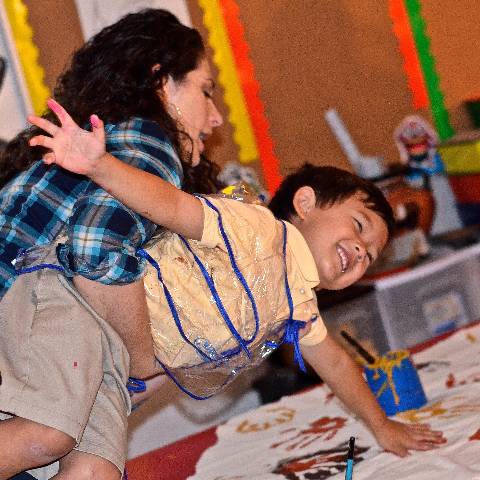

Last summer, I achieved one of my dreams: to travel throughout Spain researching the evolution of cultural expression. The Carla and Leonard Wood Faculty Professional Development Endowment Award made it possible for me to “bring Spain” to Darlington and embody our mission statement that encourages us to "Learn with Passion." I’ve used my photos, videos and cultural artifacts to make curriculum come alive in an experiential and multimedia learning environment. My goal is to foster the students' ability to make interdisciplinary connections, and to determine how the past affects the present and informs the future.
Researching at the Alambra Palace in Granada, Spain
1. In the caves of northern Spain, I explored humanity’s earliest historical record: Paleolithic art forms. I returned to Darlington and collaborated with ELA-2 Art and Spanish Teacher Susan Mann to create a unit in which my Spanish 4 students would teach her pre-kindergarten class about prehistory’s people and art, all in the Spanish language. Our Spanish 4 goal was to answer these questions: “How does art record history?” and “What traits make art forms valuable to all of humanity, regardless of national borders?”
2. Spanish 4 created storybooks based on authentic children’s books I brought back from Spain. They teamed up with pre-K students to teach them vocabulary through language charades and digital games we designed.


3. After pre-K learned vocabulary, Spanish 4 students read their storybooks and reinforced language learning.


4. Spanish 4 students experienced the conditions in which early humans painted: caverns with tight, dark spaces and uneven surfaces. Our class takes place entirely in Spanish—these experiential activities help students connect language with history and art, and to store this
knowledge in their long-term memory.


5. They learned the art techniques of prehistory: how to construct natural pigments, etch outlines in stone and paint animals and handprints.


6. Spanish 4 returned to the Thatcher campus with a new understanding of art and taught their pre-K amigo how to decorate the ceiling of a “cave.”
7. Together, students painted animals that were hunted in that era…


8. ...and covered them with colored hands and hands in “negative,” just the way adults helped youngsters apply painted hands in Paleolithic times.

9. Spanish 4 students guided pre-K amigos in the creation of our final product. This canvas shows all we have learned—from the animals hunted to the techniques of creating pigments and applying it in a communal, intergenerational manner.

10. We shared our final product with the Darlington Community at our annual Fall for the Arts festival. Learning isn’t confined to classroom spaces…we go forth and teach our friends and families.

This is what it means to “Learn with Passion!”
